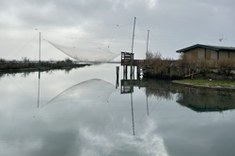Planets Come from Water: a Vast Amount of Water Vapour Observed 450 Light Years from Earth

An international team of scholars observed a quantity of water equivalent to at least three times that found in Earth's oceans in the inner part of the disk of dust and gas revolving around the star HL Tauri, located 450 light years from our planet. The results of the study - published in Nature Astronomy - reveal the presence of a large amount of water vapour stably distributed in a specific region. This configuration provides ideal conditions for the planet formation process, much like what happened 4.5 billion years ago in our Solar System.
"Until now, mapping the distribution of water inside a 'protoplanetary' disk, akin to regions where the planets of our Solar System likely formed and where other planetary systems are currently forming, was not feasible", says Leonardo Testi, professor at the Department of Physics and Astronomy “Augusto Righi” at the University of Bologna. “Through this study, we have not only detected a large amount of water in gaseous form but have also captured detailed images, allowing us to measure the distribution of water vapour in a region of planetary formation 450 light years from us.”
Water molecules are a key element for the birth of planetary systems. The significance lies in the "snow line," the distance from the star where water transitions from ice to vapor. According to theoretical models, stellar dust grains are expected to accumulate more rapidly in this region, promoting the growth of embryos that will eventually develop into planets.
However, it is not easy to observe the presence of water in planetary formation regions from Earth, due to the absorption caused by the large amount of water vapour in the Earth’s atmosphere. To overcome this obstacle, scholars relied on the extraordinary capabilities of the radio interferometer ALMA (Atacama Large Millimeter/submillimeter Array), partnered by ESO (European Southern Observatory) and located at an altitude of 5,000 metres in the Atacama Desert, Chile. The very dry environment and high altitude offer exceptional observation conditions that minimise the negative effects of water vapour in the atmosphere.
This instrument facilitated the observation of a substantial quantity of water around HL Tauri, a star in the Constellation Taurus situated 450 light-years away from Earth. The images obtained show the presence of a large amount of water vapour at a distance from the star where a local decrease in dust distribution had previously been observed,the kind of environment in which gas and dust could have accumulated into planetary embryos.
The dust particles forming stellar disks are indeed the basis for planet formation: as they collide and clump together, they produce increasingly larger bodies orbiting the star. Astronomers believe that at the point where the temperature is cold enough to turn water vapour into ice particles, the dust particles can accumulate more efficiently, thus initiating the process of planet formation.
The study was published in Nature Astronomy with the title “Imaging the water content of the inner astronomica units of HL Tau”. Leonardo Testi, professor at the Department of Physics and Astronomy “Augusto Righi”, participated for the University of Bologna.






